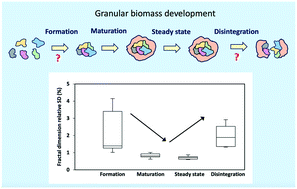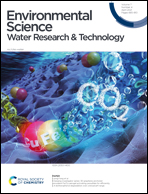Monitoring the stability of aerobic granular sludge using fractal dimension analysis†
Abstract
Cyclic episodes of granules formation and disintegration took place in two lab-scale aerobic granular sludge sequencing batch reactors, one fed with synthetic wastewater (COD: 0.6 g L−1 and NH4+–N: 0.06 g L−1) and operated at a constant organic loading rate (2.5 g COD per L d), and the other fed with real wastewater (soluble COD: 0.27–1.37 and NH4+–N: 0.02–0.16 g L−1) and with a variable loading rate (between 1.1 and 5.5 g CODsoluble per L d). The sludge volume index, density and diameter (mean value and relative standard deviation) of the granular biomass showed great fluctuations, without any clear tendency during the operational period. However, changes in granules fractal dimension values (both mean and relative standard deviation) matched with the formation and disintegration dynamics of the granular biomass. Statistical data analysis showed that the relative standard deviation of the granules fractal dimension could be a useful parameter for monitoring the granules status. Indeed, an increase of its value during the maturation or steady-state granulation stages is an early warning of disintegration episodes. A control strategy to maintain granules integrity based on this parameter is proposed.

- This article is part of the themed collection: Urgent communications in RSC Environmental Science journals


 Please wait while we load your content...
Please wait while we load your content...